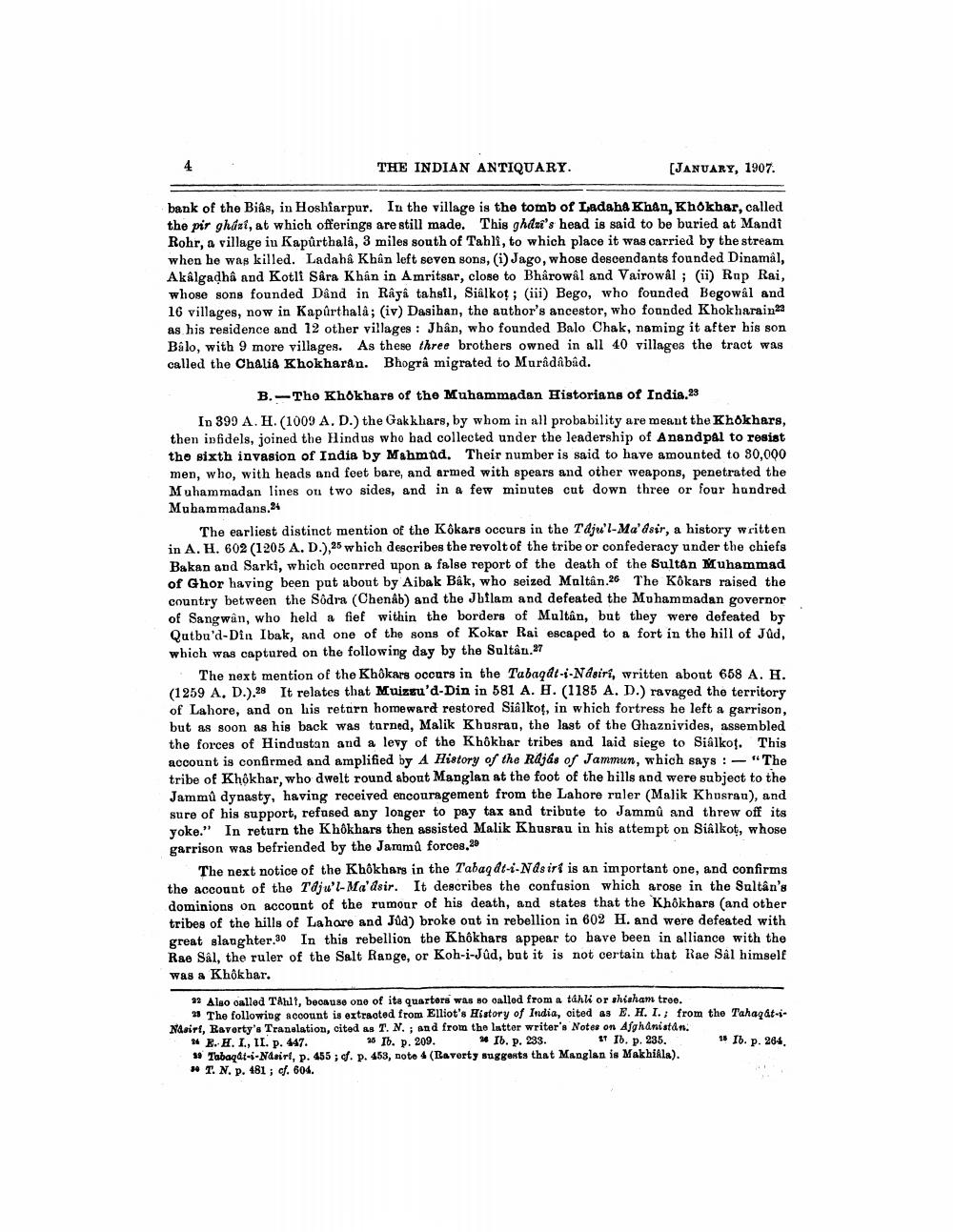Book Title: Indian Antiquary Vol 36 Author(s): Richard Carnac Temple Publisher: Swati Publications View full book textPage 8
________________ THE INDIAN ANTIQUARY. (JANUARY, 1907. bank of the Bias, in Hoshiarpur. In the village is the tomb of Ladaba Khan, Khokhar, called the pir ghazi, at which offerings are still made. This ghdzi's head is said to be buried at Mandi Rohr, a village in Kapurthala, 3 miles south of Tahli, to which place it was carried by the stream when he was killed. Ladahá Khûn left seven sons, (i) Jago, whose descendants founded Dinamál, AkÁlgadha and Kotli Sara Khan in Amritsar, close to Bhårowal and Vairowal ; (ii) Rap Rai, whose sons founded Dând in Raya tahsil, Sialkot; (iii) Bego, who founded Begowal and 16 villages, now in Kapurthala; (iv) Dasihan, the author's ancestor, who founded Khokharaina2 as his residence and 12 other villages : Jhân, who founded Balo Chak, naming it after his son Balo, with 9 more villages. As these three brothers owned in all 40 villages the tract was called the Chalia Khokharan. Bhogrâ migrated to Muradabad. B.-Tho Khokhare of the Muhammadan Historians of India.23 In 399 A. H.(1009 A, D.) the Gakkhars, by whom in all probability are meant the Khokhars, then infidels, joined the Hindus who had collected under the leadership of Anandpal to resist the sixth invasion of India by Mahmud. Their number is said to have amounted to 80,000 men, who, with heads and feet bare, and armed with spears and other weapons, penetrated the Muhammadan lines on two sides, and in a few minutes cut down three or four hundred Muhammadans.24 The earliest distinct mention of the Kökars occurs in the T dju'l-Ma'asir, a history written in A. H. 602 (1205 A.D.),25 which describes the revolt of the tribe or confederacy under the chiefs Bakan and Sarki, which occurred upon a false report of the death of the Sultan Muhammad of Ghor having been put about by Aibak Bâk, who seized Multân.26 The Kókars raised the country between the Sodra (Chenab) and the Jbilam and defeated the Muhammadan governor of Sangwan, who held a fief within the borders of Multân, but they were defeated by Qutbu'd-Din Ibak, and one of the sons of Kokar Rai escaped to a fort in the hill of Jad, which was captured on the following day by the Sultâu.27 The next mention of the Khokars occurs in the Tabaqd1-4-Nasiri, written about 658 A. H. (1259 A. D.).28 It relates that Muizzu'd-Din in 581 A. H. (1185 A. D.) ravaged the territory of Lahore, and on his return homeward restored Sialkot, in which fortress he left a garrison, but as soon as his back was turned, Malik Khusran, the last of the Ghaznivides, assembled the forces of Hindustan and a levy of the Khôkbar tribes and laid siege to Sialkot. This account is confirmed and amplified by A History of the Rūjas of Jammun, which says : - "The tribe of Khokhar, who dwelt round about Manglan at the foot of the hills and were subject to the Jammû dynasty, having received encouragement from the Lahore ruler (Malik Khusran), and sure of his support, refused any longer to pay tax and tribute to Jammû and threw off its yoke." In return the Khôkhars then assisted Malik Khusrau in his attempt on Sialkot, whose garrison was befriended by the Jaromů forces.20 The next notice of the Khokhars in the Tabaq dt-i-Nasiri is an important one, and confirms the account of the Tdju'l-Ma'lsir. It describes the confusion which arose in the Sultan's dominions on account of the rumour of his death, and states that the Khokhars (and other tribes of the hills of Lahore and Jud) broke out in rebellion in 602 H. and were defeated with great slaughter 30 In this rebellion the Khokhars appear to bave been in alliance with the Rae Sal, the ruler of the Salt Range, or Koh-i-Jûd, but it is not certain that Rae Sal himself was a Khôkhar. » Also called TANT, boonuso one of its quarters was so called from a táhli or shisham troo. 2 The following account is extracted from Elliot's History of India, oited as E. H. I.from the Tahaqat-iNoirt, Ravorty'. Translation, cited as T. N.; and from the latter writer's Notes on Afghanistan. * E. H. I., II. p. 447. 26 Ib. p. 209. Ib. p. 233. 1 Ib. p. 235. * 16. p. 264. Tabaqdt-i-Noirt, p. 455;. p. 453, note 4 (Raverty suggests that Manglan is Makhila). # T. N. p. 481 ; f. 604.Page Navigation
1 ... 6 7 8 9 10 11 12 13 14 15 16 17 18 19 20 21 22 23 24 25 26 27 28 29 30 31 32 33 34 35 36 37 38 39 40 41 42 43 44 45 46 47 48 49 50 51 52 53 54 55 56 57 58 59 60 61 62 63 64 65 66 67 68 69 70 71 72 73 74 75 76 77 78 79 80 81 82 ... 430
